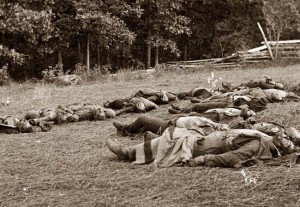1913 Natives Land Act Power Point
In South African history, one of the most important pieces of legislation that set up the system of Segregation and laid the foundations of the later Apartheid was the 1913 Natives Land Act. This act restricted the land rights of many black Africans, condemning them to marginal land and setting up a system of coercion and control, all in the name of white dominance. What historical processes led to this act being passed? An analysis of Rudolph Daniels piece entitled, “The Agrarian Land Question in South Africa in Its Historical Context, 1652-1988” will show that the precedent for this act began in the early years of colonization, when whites forced blacks to live on marginal land either through conquest or treaty. Then, in the late 1800’s, a series of squatter laws cropped up throughout South Africa in response to the perceived serious threat of squatting – the practice of a person, in this case a farmer, utilizing land for his own purposes without paying taxes or rent. According to Daniels, then, the 1913 Natives Land Act was partially an attempt to deal with squatters, both to increase the labor pool, and to increase the output of farms. However, Harvey M. Feinberg shows in his text, “The 1913 Natives Land Act in South Africa: Politics, Race, and Segregation in the Early 20th Century” that the most important proponent of the law was Prime Minister Botha’s government who, in an attempt to retain party unity within the South African Party, pushed for the law to be passed to appease the radical elements from the Orange Free State delegation in Parliament led by parliamentary member Hertzog. Though the act eventually failed to keep the South African Party united, it was not repealed or significantly altered as it served its purpose of legalized white domination, underscored the inferiority of blacks, and encouraged labor for industry and the mines.
Daniels points out that there was a long historical tradition of segregation between Europeans and Africans, and that this view was traditionally seen as the best alternative to direct living. This was known as the “natural policy” and it was first implemented following the trekker migrations away from Cape Town and into the mainland. When the trekkers encountered a native people group, they would force them away by treaty or military domination. As Daniels points out “This was sometimes accompanied by violence and war, but much more frequently it was a silent process… Possession meant different things to Europeans and to Africans.” To a European, possession meant the legal rights to the property, physically owning it. To an African, it simply meant the right for temporary use. Thus, when Europeans signed treaties pushing Africans out of Europeans desired farmland, it was easy to coerce Africans. Those who realized what was happening and resisted were attacked militarily. The result was the creation of “reservations” wherein blacks were allowed to live as they pleased but only so long as whites approved and had no need of their land or resources. These reservations were common place in the Boer republics of the Transvaal and Orange Free State in the 1850’s, a significance that will be explored later (Daniels 328-329).
Meanwhile, the British also practiced segregation and the “natural policy” when they came to rule the cape colony throughout the early- to mid-1800’s, though unlike the Boer’s who viewed it as a policy of conquest and domination, the British saw it as the simplest way to deal with the “native question.” If natives were pushed out of the way and allowed to live as they pleased, it would solve the problem of assimilation. The British also used segregation and the establishment of reserves to create buffers between hostile tribes and colonial farmers. They would recruit remnants from conquered tribes and set them up on their own tribal lands. Thus the “natural policy” was seen both as a humanitarian solution and an act of cultural domination (Daniels 330-331).
With the advent of the industrial revolution, sparked by the discovery of diamonds in Kimberley in 1867 and gold in the Witwatersrand in 1886, the relatively strict use of “natural policy” was abolished as whites looked for cheap labor to work in their mines. Moving Africans out of their reservations and away from their families was accomplished through two main avenues: the establishment of labor recruitment agencies and a series of new taxes proposed from 1890-1895 on rural Africans forcing them to find labor. However, the migration of blacks off of their reservations created new problems with squatters – blacks who utilize white owned-land or Crown Land without paying rent or taxes or refuse to receive wages for their labor and instead have private, entrepreneurial goals. The various colonies and the two Boer Republics attempted to combat this with anti-squatter laws, but by and large these laws were ineffective because they required the use of violence to coerce blacks into either becoming laborers. This often hurt the labor pool, making them unpopular with white farmers who required labor to farm effectively. Thus the laws went unenforced. Except for the Cape Colony, which imposed a law that forced squatters to work as farm laborers or else they had to pay a steep tax (Daniels 331-333).
The final element of the historical processes leading up to the 1913 Natives Land Act discussed by Daniels was the need for increased farm production. As the industrial revolution was ramping up, it put more demands on white farmers. These farmers began fencing off their land, preventing blacks from squatting on it. This caused two things: it exacerbated the squatting problem, and it encroached on blacks land, forcing them on more marginal land within their reservations. This land became overworked, depleting the soil, and causing an agricultural crisis. Daniels points out that, rather than raising concern, this phenomenon was looked upon favorably by the white community, as it became another factor among the forces that increased the labor pool with blacks. With the increased problem of squatting, and the value of the increase in labor, these issues were seen as something that had to be solved by the new government of the Union of South Africa (Daniels 334-335).
Feinberg begins an analysis of the political climate surrounding the bill. According to Feinberg, the reason the 1913 Natives Land Act was passed at that particular historical juncture with the language it contained had very little to do with economic conditions or squatters, but instead because of the hostile political climate between Prime Minister Louis Botha and Member of Parliament James Barry Munnik Hertzog. In 1910, the first election of the new Union of South Africa took place. Britain appointed Louis Botha to be the first Prime Minister of South Africa. Botha had the difficult task of creating a sustainable government out of the majority party, the South African Party, which itself was a coalition of progressive-liberal politicians from the Cape Province and more aggressive and reactionary politicians from the Boer provinces. Botha was hesitant to give Hertzog a Cabinet post due to his more radical ideologies, however, when Hertzog refused to approve an appeals court judge, Botha was forced to accept him onto the Cabinet. Unfortunately, over the next two years, relations remained tenuous. Hertzog was an unapologetic Afrikaner nationalist from the Orange Free State, who, among other things, demanded that Afrikans be the primary language of South Africa, and barring this, that it should be of equal importance to English. On top of this, Hertzog desired a “South Africa first” policy, whereby South Africa would retain the right to choose whether or not to support the British depending on the situation. Complicating matters, Hertzog was not afraid to promote his ideologies, even if it meant usurping the prime ministers authority. Often acting of his own accord, he said things that contradicted the official party view, often at inappropriate moments, causing political backlash and embarrassing Botha. In response to Hertzog’s rash actions and statements, Botha and the rest of the cabinet resigned. Following this, the governor-general of the dominion requested Botha to form a new cabinet, of which Hertzog was not a member (Feinberg 70-80) .
The loss of Hertzog had to be carefully politically calculated. In 1910, the South African Party had won 67 seats, while the Unionists and won 39, the Labour Party 4, and 11 independents. Thus the South African Party’s held a majority by 13 seats (67-54). Meanwhile, sixteen South African Party members fell into Hertzog’s camp. Hertzog would only need to convince 6 of these sixteen members to follow him in leaving the South African Party and force the creation of a new government. How could Botha appease these members and maintain his government? The answer was by passing some of their radical Boer legislation (Feinberg 79).
The 1913 Natives Land Act was presented by Sauer, a member of Botha’s cabinet who was actually a Cape liberal who believed in the expansion of voting rights among blacks. The act appears to have followed not only the outline of the previous act dealing with squatters in the Cape, but it also followed the architecture of a draft bill rumored to have been proposed by Hertzog. This was clearly an attempt to appease the more radical Boer elements in parliament, especially because, rather than being a law that dealt strictly with squatters, it also prohibited the sale of land to blacks. This was a law that, at the time, only existed in the Orange Free State. By including it in the law, it was hoped to appease Orange Free State politicians, which made up the 16 members of parliament in Hertzog’s camp, by extending part of the radical Afrikans ideology which existed there throughout South Africa. Thus, to keep the party together and prevent a national crisis, the act had to be accepted (Feinberg 79-80).
a wordle of the 1913 Natives Land Act. Notice that “Orange” is present.
Finally, the bill was found agreeable by a myriad of politicians because the main “principle” of the bill, according to 15 of the 17 people who discussed it’s “principle”, was for segregation. Many newspapers, journals, and magazines agreed, such as the South African Agricultural Journal, which claimed the bills push was “to provide lines of demarcation between natives and non-natives.” Nearly all of the white members of parliament believed Segregation was a good idea, even if they may not have agreed on the prohibition of land and the outright oppression of blacks. When confronted with the topic of Segregation, many politicians favored it, believing that it would allow Africans to continue their traditions and develop on their own. Even John Dube, founder of the South African Native National Congress, wasn’t against the concept, as long as it was a fair division of land. Lastly, the many politicians agreed to pass the bill because of a list of exemptions. The Cape Province was exempted from almost the entire bill since it contained one of the highest black populations, among them free black “amakholwa” who were given the right to vote. Meanwhile, the Transvaal and Natal didn’t have the harsh anti-squatting elements of the bill. With these provisions, the bill was passed on June 19, 1913 (Feinberg 103-105).
A wordle of John Dube’s letter to the British Public
While a knowledge of the historic processes that led to the passing of the Natives Land Act and the politicians intentions in passing the act is valuable, it’s also important to discuss what wasn’t intentional. One speculation is that the bill was passed to increase the labor pool for the industrialized society. However, there is very little evidence for this. Many of the few members of Parliament that discussed the bill worried that it would actually lower the amount of labor available, since Africans would have access to their own designated land. Meanwhile, private enterprises, such as mining organizations, hardly paid attention to the bill, showing no interest in its passing. Feinberg states, “The Annual Report of the Chamber of Mines for 1913 does not list the Natives Land Act among acts ‘of interest to the mining industry.’” (Feinberg 105-109)
The South African parliament passed the act based on historical precedence, response to societal problems, and political pressures. For much of South Africa’s colonial history, demarcating territory for blacks took place. This “natural policy” established a precedent that made segregation acceptable not only to the white politicians, but some black leaders such as John Dube (though it had to be “fair”). As the industrial revolution kicked off, squatters became a serious issue. In response, a series of acts were passed, culminating in the 1913 Natives Land Act. However, the Act was worded in such a way as to appease the more radical members of the South African Party, thus aiming to retain party unity. This political maneuvering was the primary basis for the act at the time it was passed.
_______________________________________________________________________________________
To preserve this piece, I would save all relevant files to my computer, a USB flash drive, a portable harddrive, and a cloud storage. I would ensure that my flash drive and harddrive were not all in the same place in case it some how got damaged. I could also save it in more than one format; for example, I have a power point and microsoft word document. Thus, by having this on my computer and blog, I inadvertently have helped “preserve” it.
Photos on power point can be found:
And here







